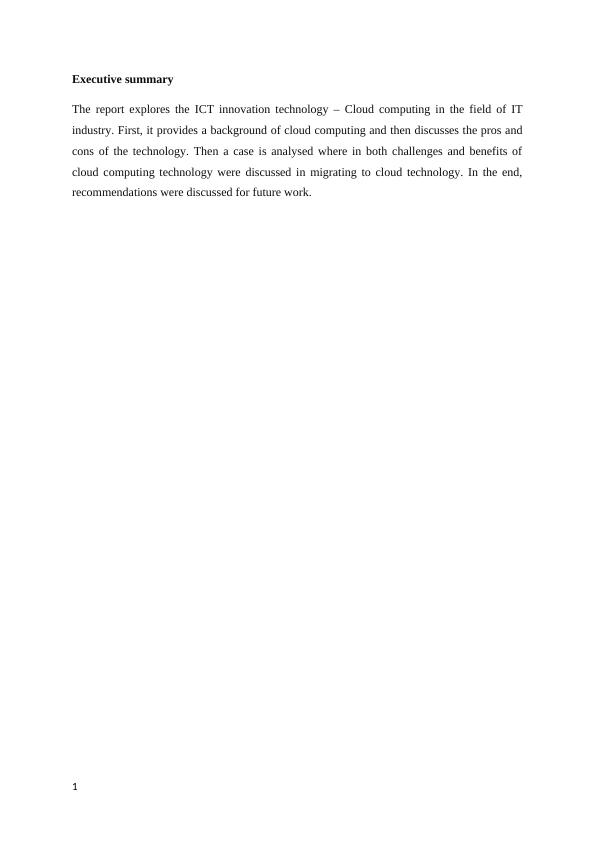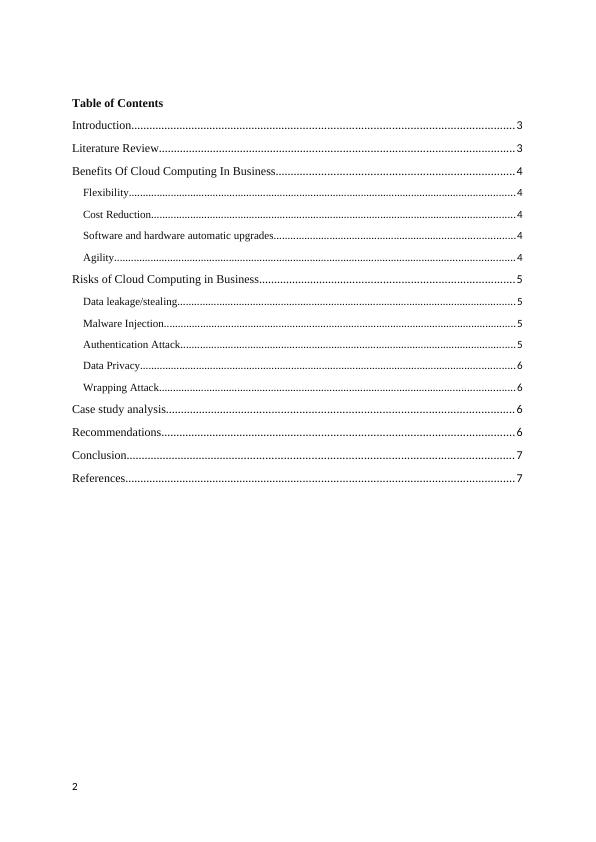Cloud Computing in Business: Benefits and Risks
Added on 2023-06-04
8 Pages2367 Words101 Views
Executive summary
The report explores the ICT innovation technology – Cloud computing in the field of IT
industry. First, it provides a background of cloud computing and then discusses the pros and
cons of the technology. Then a case is analysed where in both challenges and benefits of
cloud computing technology were discussed in migrating to cloud technology. In the end,
recommendations were discussed for future work.
1
The report explores the ICT innovation technology – Cloud computing in the field of IT
industry. First, it provides a background of cloud computing and then discusses the pros and
cons of the technology. Then a case is analysed where in both challenges and benefits of
cloud computing technology were discussed in migrating to cloud technology. In the end,
recommendations were discussed for future work.
1

Table of Contents
Introduction..............................................................................................................................3
Literature Review.....................................................................................................................3
Benefits Of Cloud Computing In Business..............................................................................4
Flexibility..........................................................................................................................................4
Cost Reduction..................................................................................................................................4
Software and hardware automatic upgrades......................................................................................4
Agility...............................................................................................................................................4
Risks of Cloud Computing in Business....................................................................................5
Data leakage/stealing.........................................................................................................................5
Malware Injection..............................................................................................................................5
Authentication Attack........................................................................................................................5
Data Privacy......................................................................................................................................6
Wrapping Attack...............................................................................................................................6
Case study analysis.................................................................................................................. 6
Recommendations....................................................................................................................6
Conclusion............................................................................................................................... 7
References................................................................................................................................7
2
Introduction..............................................................................................................................3
Literature Review.....................................................................................................................3
Benefits Of Cloud Computing In Business..............................................................................4
Flexibility..........................................................................................................................................4
Cost Reduction..................................................................................................................................4
Software and hardware automatic upgrades......................................................................................4
Agility...............................................................................................................................................4
Risks of Cloud Computing in Business....................................................................................5
Data leakage/stealing.........................................................................................................................5
Malware Injection..............................................................................................................................5
Authentication Attack........................................................................................................................5
Data Privacy......................................................................................................................................6
Wrapping Attack...............................................................................................................................6
Case study analysis.................................................................................................................. 6
Recommendations....................................................................................................................6
Conclusion............................................................................................................................... 7
References................................................................................................................................7
2

Introduction
In a modern business environment of today, cloud computing systems has turned out to be an
integral part of it and is growing in popularity on a daily basis. However, cloud computing as
a whole solves some problem but also creates some new ones. This report presents a holistic
view of the cloud computing technology, it’s usage in current enterprises and its core
advantages as well as disadvantages for a modern business environment. Specifically, this
report would the objectives of the project, the search questions, the scope, limitations and
research methodology.
Literature Review
Cloud computing could be explained as a computing model that serves on-demand access to a
commonly shared pool of ICT based resources such as end-user application, middleware,
networks, storage systems, operating systems, services among others. Overall, a cloud
computing system has 3 different services and 4 different types of deployment models.
Services include, SaaS, the IaaS and the SaaS. On the other hand, the deployment model
includes include Private cloud, Public Cloud, Hybrid Cloud and Community based cloud
(AlHakami, 2012). Cloud computing-based solutions have some key features and it includes
broad network access, on-demand self-service, tiered service, measurable service delivery,
rapid flexibility and resource pooling. Now, on-demand self-service are easily accessible with
extremely low amount of intervention from personnel as they are entirely automated. All of
these services are also delivered to the audience in real-time. Apart from that, the cloud
services access is made possible via various platforms including laptops and mobile phones
via internet. Resource Pooling: Since the resources are being pooled from the cloud, multiple
users can be served at one single moment using similar resources (Bisong and M. Rahman,
2011). Also, these resources are then dynamically linked to different sets of users whenever
they need storage, virtual machines and memory . Cloud delivered solutions are rapidly
elastic and fully flexible and thus they can be scaled up and down as the needs be. Apart from
this, the services are measured as well which in turn means that the end-user is only charged
when the system is being used based on the bandwidth, the processing power, the storage
used among others.
Cloud computing systems has become highly popular and common around the globe owing
to the following main characteristics including less cost, pricing model, low emission of
3
In a modern business environment of today, cloud computing systems has turned out to be an
integral part of it and is growing in popularity on a daily basis. However, cloud computing as
a whole solves some problem but also creates some new ones. This report presents a holistic
view of the cloud computing technology, it’s usage in current enterprises and its core
advantages as well as disadvantages for a modern business environment. Specifically, this
report would the objectives of the project, the search questions, the scope, limitations and
research methodology.
Literature Review
Cloud computing could be explained as a computing model that serves on-demand access to a
commonly shared pool of ICT based resources such as end-user application, middleware,
networks, storage systems, operating systems, services among others. Overall, a cloud
computing system has 3 different services and 4 different types of deployment models.
Services include, SaaS, the IaaS and the SaaS. On the other hand, the deployment model
includes include Private cloud, Public Cloud, Hybrid Cloud and Community based cloud
(AlHakami, 2012). Cloud computing-based solutions have some key features and it includes
broad network access, on-demand self-service, tiered service, measurable service delivery,
rapid flexibility and resource pooling. Now, on-demand self-service are easily accessible with
extremely low amount of intervention from personnel as they are entirely automated. All of
these services are also delivered to the audience in real-time. Apart from that, the cloud
services access is made possible via various platforms including laptops and mobile phones
via internet. Resource Pooling: Since the resources are being pooled from the cloud, multiple
users can be served at one single moment using similar resources (Bisong and M. Rahman,
2011). Also, these resources are then dynamically linked to different sets of users whenever
they need storage, virtual machines and memory . Cloud delivered solutions are rapidly
elastic and fully flexible and thus they can be scaled up and down as the needs be. Apart from
this, the services are measured as well which in turn means that the end-user is only charged
when the system is being used based on the bandwidth, the processing power, the storage
used among others.
Cloud computing systems has become highly popular and common around the globe owing
to the following main characteristics including less cost, pricing model, low emission of
3

End of preview
Want to access all the pages? Upload your documents or become a member.
Related Documents
Cloud Computing: Types, Advantages and Disadvantageslg...
|8
|1314
|485
Issues of Cloud Computing and Research Opportunitieslg...
|8
|2180
|443
Comparing PaaS offerings in light of SaaS developmentlg...
|13
|2750
|11
Future Generation Computer Systemslg...
|3
|2952
|13
Cloud Computing Security PDFlg...
|13
|3038
|39
Digital Marketing | Assignment Samplelg...
|9
|1751
|90